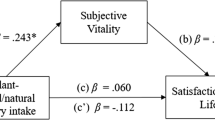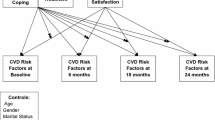Abstract
It has been reported that adults suffering from refractory essential hypertension experience significantly fewer positive life events than healthy peers. However, the influence of positive life events on blood pressure (BP) in adolescents has been largely ignored. Therefore, we examined the relationship between selfreported positive life events and BP in 69 sixth graders with a mean age of 11.7 years. Positive life events were assessed with the Adolescent Perceived Events Scale and resting blood pressure was measured with a mercurial sphygmomanometer. Correlational analyses showed an inverse relationship between positive life events and diastolic BP, suggesting that adolescents experiencing more positive life events were more likely to have lower diastolic BP's. Hierarchical regression analyses revealed that physical activity level, dietary sodium-to-potassium ratio, parental history of hypertension, and measures of body composition predicted 24.6% of the variance in systolic BP and 34.6% of the variance in diastolic BP. Moreover, positive life events predicted an additional 4.3% of the variance in diastolic BP when statistically controlling these established risk factors for hypertension. These results suggest that increased perceptions of positive life events may act as a buffer to elevated BP in adolescents.
Similar content being viewed by others
References
Althoff, S. A., Svoboda, M., and Girdano, D. A. (1988). Choices in Health and Fitness for Life, Gorsuch Scarisbrick, Scottsdale.
American Heart Association (1990). Heart and stroke facts (Order No. 55–0376).
American Heart Association (1995). Inquires Guide 1995, American Heart Association, Dallas.
Brody, M. J., Natelson, B. H., Anderson, E. A., Folkow, B., Levy, M. N., Obrist, P. A., Reis, D. J., Phil, D., Rosenman, R. H., and Williams, R. B. (1978). Task force 3: Behavioral mechanisms in hypertension. Circulation 76(Suppl. 1): I-95-I-99.
Byrne, D. G. (1987). Personality, life events and cardiovascular disease. J. Psychosom. Res. 31(6): 661–671.
Clarke, W. R., and Lauer, R. M. (1993). Does childhood obesity track into adulthood? Crit. Rev. Food Sci. Nutri. 33: 423–430.
Compas, B. E., Davis, G. E., Forsythe, C. J., and Wagner, B. M. (1987). Assessment of major and daily stressful events during adolescence: The adolescent perceived events scale. J. Consult. Clin. Psychol. 55: 534–541.
Compas, B. E., Howell, D. C., Phares, V., Williams, R. A., and Ledoux, N. (1989). Parent and child stress symptoms: An integrative analysis. J. Dev. Psychol. 25: 550–559.
Croft, J. B., Keenan, N. L., Sheridan, D. P., Wheeler, F. C., and Speers, M. A. (1995). Waist-to-hip ratio in a biracial population: Measurement, implications, and cautions for using guidelines to define high risk for cardiovascular disease. J. Am. Diet. Assoc. 95: 60–64.
Gordon, C. C., Chumlea, W. C., and Roche, A. F. (1988). Stature, recumbent length, and weight. In Lohman, T. G., Roche, A. F., and Martorell, R. (eds.) , Anthropometric Standardization. Reference Manual (3–8), Human Kinetics, Champaign, IL.
Gortmaker, S. L., Dietz, W. H., Sobol, A. M., and Wehler, C. A. (1987). Increasing pediatric obesity in the United States. Am. J. Dis. Child 141: 535–540.
Groer, M., Thomas, S., Droppleman, P., and Younger, M. (1994). Longitudinal study of adolescent blood pressures, health habits, stress, and anger. Health Values 18: 25–33.
Hansen, H. S., Froberg, K., Hyldebrandt, N., and Nielsen, J. R. (1991). A controlled study of eight months of physical training and reduction of blood pressure in children: The Odenese schoolchild study. Brit. Med. J. 30: 682–685.
Harrison, G. G., Buskirk, E. R., Carter, J. E. L., Johnston, F. E., Lohman, T. G., Pollock, M. L., Roche, A. F., and Wilmore , J. (1988). Skinfold thicknesses and measurement technique. In Lohman, T. G., Roche, A. F., and Martorell, R. (eds.), Anthropometric Standardization Reference Manual (3–8) , Human Kinetics, Champaign, IL.
Herd, J. A. (1991). Cardiovascular response to stress. Psychol. Rev. 71: 305–329.
Holmes, T., and Rahe, R. H. (1967). The social readjustment rating scale. J. Psychosom. Res. 4: 189–194.
Howard, J. K. H., Bindler, R. M., Dimico, G. S., Norwood, S. L., Nottingham, J. P. Synoground, G., Trilling, J. A., Van Gemert, F. C., Kirk, M. C., Newkirk, G. R., Leaf, D. A., and Cleveland, P. D. (1991). Cardiovascular risk factors in children: A Bloomsday research report. J. Pediat. Nurs. 6: 222–229.
Isaksson, H., Konarski, K., and Theorell, T. (1992). The psychological and social condition of hypertensives resistant to pharmacological treatment. Soc. Sci. Med. 35: 869–875.
Jemerin, J. M., and Boyce, W. T. (1990). Psychobiological differences in childhood stress response. II. cardiovascular markers of vulnerability. Dev. Behav. Pediatr. 11: 140–150.
Johnson, E. H., Schork, N. J., and Spielberger, C. D. (1987). Emotional and familial determinants of elevated blood pressure in black and white adolescent females. J. Psychosom. Res. 31: 731–741.
Johnson, J. H., and McCutcheon, S. M. (1980). Assessing life stress in older children and adolescents: Preliminary findings with the life events checklist. In Sarason, I. G., and Spielberger, C. D. (eds.), Stress and Anxiety, Vol. 7, Hemisphere, Washington, DC, pp. 111–125.
Johnston, F. E., Hamill, P. V. V., and Lemeshow, J. (1982). Skinfold Thickness of Children 6–11 Years (National Health Survey, Series 11, No. 120), U.S. Government Printing Office, Washington, DC.
Johnston, F. E., Hamill, P. V. V., and Lemeshow, J. (1984). Skinfold Thickness of Children 12–17 Years (National Health Survey, Series 11, No. 132), U.S. Government Printing Office, Washington, DC.
Joint National Committee on Detection, Evaluation, and Treatment of High Blood Pressure. (1993). The fifth report of the Joint National Committee on Detection, Evaluation, and Treatment of High Blood Pressure (JNCV). Arch. Intern. Med. 153: 154–183.
Lauer, R. M., and Clarke, W. R. (1989). Childhood risk factors for high adult blood pressure: The Muscatine Study. Pediatrics 84: 633–641.
Lazarus, R. S. (1984). Puzzles in the study of daily hassles. J. Behav. Med. 7: 375–389.
Lazarus, R. S., and Folkman, S. (1984). Stress, Appraisal, and Coping, Springer, New York.
Livingston, I. L. (1993). Stress, hypertension, and young black Americans: The importance of counseling. J. Multicult. Counsel. Dev. 21: 132–142.
Lohman, T. G. (1992). Advances in Body Composition Assessment, Human Kinetics, Champaign, IL.
Melby, C. L., Goldflies, D. G., Hyner, G. C., and Lyle, R. M. (1989). Relation between vegetarian/nonvegetarian diets and blood pressure in black and white adults. Am. J. Public Health 79: 1283–1288.
Newcomb, M., Huba, G., and Bentler, P. (1981). A multidimensional assessment of stressful life events among adolescents: Derivation and correlates. J. Health Soc. Behav. 22: 400–414.
Ross, T. D., Dorson, C. O., Gilbert, G. G., and Katz, S. J. (1985). New standards for fitness measurement. J. Psych. Educ. Recreat. Dance 56: 62–66.
Rowland, T. W. (1992). Exercise, nutrition, and the prevention of cardiovascular disease: A pediatric perspective. Med. Exercise Nutr. Health 1: 34–41.
Sallis, J. F., Condon, S. A., Goggin, K. J., Roby, J. J., Kolody, B., and Alcaraz, J. E. (1993). The development of self-administered physical activity surveys for 4th grade students. Res. Q. Exercise Sport 64: 25–31.
Scott, C. B. (1993). Blood pressure and exercise. Am. Coll. Sports Med. Cert. News 3(2): 1–3.
Slaughter, M. H., Lohman, T. G., Boileau, R. A., and Horswill, C. A. (1988). Skinfold equations for estimation of body fatness in children and youth. Hum. Biol. 60: 709–723.
Strong, W. B., Deckelbaum, R. J., Gidding, S. S., Kavey, R. W., Washington, R., Wilmore, J. H., and Perry, C. L. (1992). Integrated cardiovascular health promotion in childhood. Circulation 85: 1638–1650.
Svensson, J., and Theorell, T. (1983). Life events and elevated blood pressure in young men. J. Psychosom. Res. 27: 445–456.
Swearingen, E. M., and Cohen, L. H. (1985). Measurement of adolescents' life events: The junior high school life experiences survey. Am. J. Commun. Psychol. 13: 69–85.
Task Force on Blood Pressure Control in Children (1987). Report of the second task force on blood pressure control in children—1987. Pediatrics 79: 1–25.
Theorell, T., Svensson, J., Knox, S., Waller, D., and Alvarez, M. (1986). Young men with high blood pressure report few recent life events. J. Psychosom. Res. 30: 243–249.
Wagner, B. M. (1990). Major and daily stress and psychopathology: On the adequacy of the definitions and methods. Stress Med. 6: 217–226.
Wagner, B. M., Compas, B. E., and Howell, D. C. (1988). Daily and major life events: A test of an integrative model of psychosocial stress. Am. J. Commun. Psychol. 16: 189–205.
Winkleby, M. A., Ragland, D. R., and Syme , S. L. (1988). Self-reported stressors and hypertension: Evidence of an inverse association. Am. J. Epidemiol. 127: 124–134.
Winkleby, M. A., Jatulis, D. E., Frank, E., and Fortman, S. P. (1993). Socioeconomic status and health: How education, income , and occupation contribute to risk factors for cardiovascular disease. Am. J. Public Health 83: 289–290.
Rights and permissions
About this article
Cite this article
Caputo, J.L., Rudolph, D.L. & Morgan, D.W. Influence of Positive Life Events on Blood Pressure in Adolescents. J Behav Med 21, 115–129 (1998). https://doi.org/10.1023/A:1018771706685
Issue Date:
DOI: https://doi.org/10.1023/A:1018771706685




